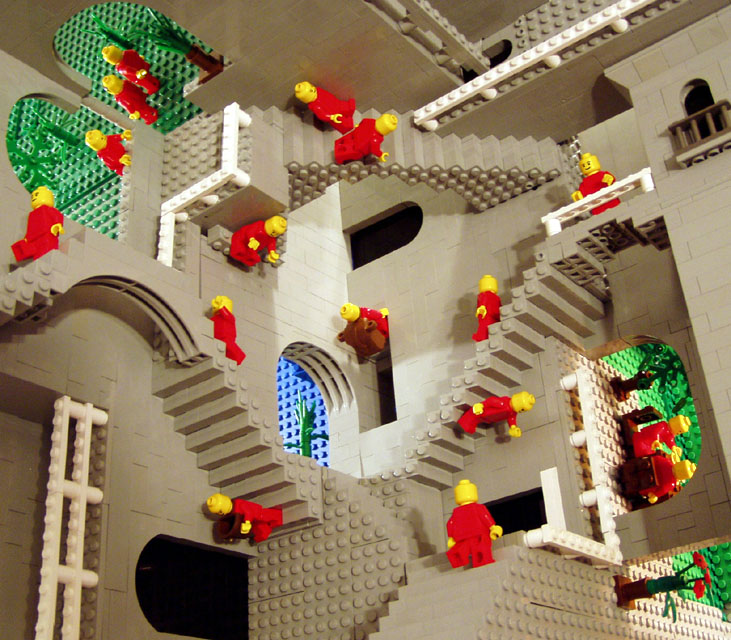
Because The LEGO Company get paranoid about this sort of thing let me make it clear that I have no affiliation with them, that my views are my own and do not necessarily represent theirs, and so on. So if you think any of this is official you are as deluded as they are.
Click on the picture or here for a bigger version (about 410K)
Daniel Shiu and I worked on this as a joint project after we finished our rendition of Escher's "Ascending and Descending", making it our fourth Escher picture rendered in LEGO. Once again, no camera tricks, but the picture has to be taken from exactly the right place, and boy did we get tired of trying to find where that place was. The whole thing took five or six evenings spread over two or three weeks. Most of the last evening was taken up with setting up the lighting the way we wanted it and trying to get the camera position just right... The original Escher picture (Relativity, 1953. Lithograph) is shown on the right for comparison. Unlike many of Escher's other "impossible" pictures (like "Ascending and Descending") , there is actually no optical illusion involved here. Gravity seems to be working in three different directions simultaneously, but the picture shows a perfectly self-consistent physical scene. So modelling it should certainly be feasible. But while Escher's picture has three different "up"s, LEGO isn't quite so flexible... For LEGO afficionados, the most significant thing about our version is the widespread use of SNOT ("Studs not on top") techniques - in plain English, having the LEGO studs pointing in lots of different directions. There are various tricks for making this work in general, and we probably used all of them here. You can find some of the details in the construction pictures. |
|
Click on the small pictures for larger versions.
|
|
|
|
|
|
|
All M. C. Escher works (C) Cordon Art, Baarn, the Netherlands. All rights reserved. Used by permission. The official M.C. Escher web site is worth a visit. In particular they have a "virtual ride" through "Ascending and Descending".
All other pictures on this page are Copyright © A. Lipson 2003.
LEGO ® is a trademark of The LEGO Group, who have nothing to do with this or any of my other LEGO-related web pages.
Our other LEGO renditions of Escher works are "Balcony", "Belvedere" and "Ascending and Decending" and "Waterfall".
Back to ASL's home page
Back to ASL's LEGO page
Hits since 11th April 2003:
|
Powered by counter.bloke.com
This page last modified 1st April 2005